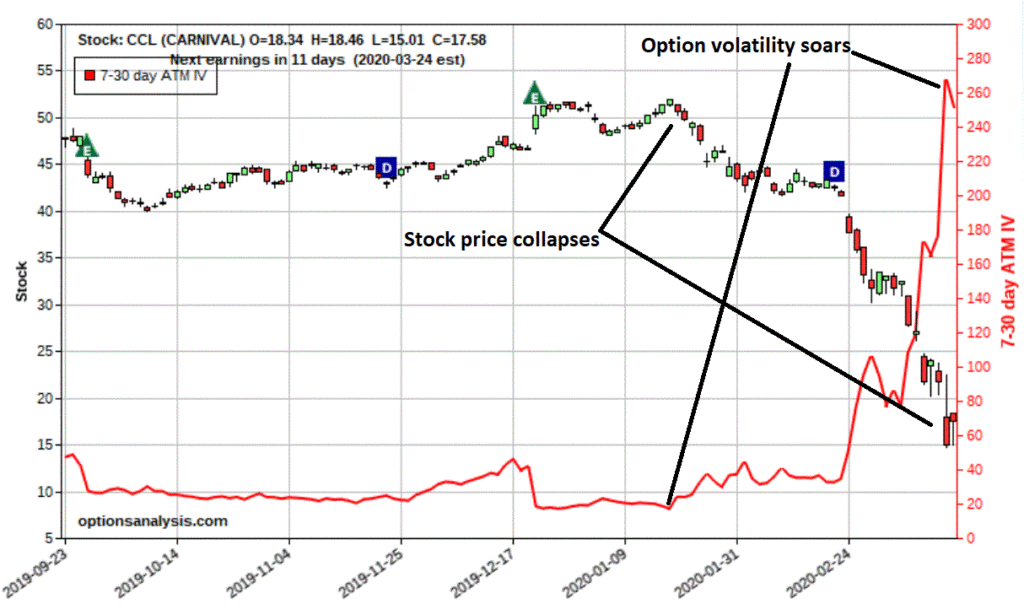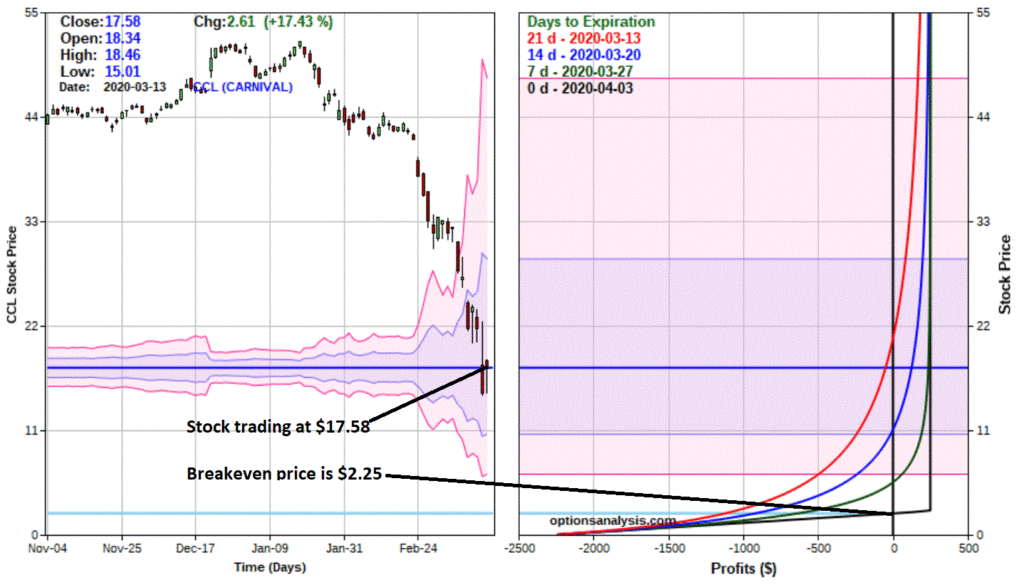To help you decide if you want to go ahead and read this article, take the following short quiz:
Carnival Cruise Lines (CCL) is presently trading at $17.58 (FYI, this article was written on Saturday 3/14/20, by the time you read this, stock and option prices may be very different):
Question #1: Do you think CCL will be trading above $2.25 a share 3 weeks from now?
Question #2: Would you like to make 11.1% in 3 weeks?
If you answered “Yes”, (or at least “Maybe”) to the first two questions, then please continue reading:
In this article, I highlighted one way to potentially take advantage of high volatility in cruise line stocks. That article focused on selling a very long-term put option (expiring in January 2021) for ticker RCL with the expectation (hope?) that implied volatility would at some point plummet and allow an early profit to be taken. The alternative was to buy 100 shares of stock at an effective price of $12.70 (the stock was trading at $32.75 at the time).
In this article we will look at something shorter-term.
A Cash Secured Put on Carnival Cruise Lines (CCL)
Figure 1 displays the price action for CCL along with the implied volatility for shorter-term options.

Figure 1 – CCL price collapses, CCL options IV soars (Courtesy www.OptionsAnalysis.com)
For CCL we will use the following example trade (remember, these are NOT recommendations, only examples).
*CCL stock is trading at $17.58 a share
*We will sell 10 April03 2.5 puts at the bid price of $0.25 per option
*These options expire in 21 days
Here are how the numbers work out:
*We need to have cash on hand sufficient to buy 1,000 shares (10 puts x 100 shares each) of CCL. This comes to $2,500 ($2.50 strike price x 10 puts x 100 shares each = $2,500)
*For selling the 10 puts we take in $250 in premium (short 10 puts at $0.25 x 100 shares per put = $250)
*As a result, our actual risk is $2,250 ($2,500 cash to secure the puts minus $250 in premium received)
Figure 2 and 3 show the particulars and risk curves

Figure 2 – CCL cash secured put position particulars (Courtesy www.OptionsAnalysis.com)

Figure 3 – CCL cash secured put position risk curves (Courtesy www.OptionsAnalysis.com)
The possible outcomes:
*If CCL completely collapses: we could end up buying 1,000 shares at $2.50 apiece. But remember, since we took in $0.25 for each option, we sold our effective buy price is $2.25 a share ($2.50 – $0.25 = $2.25)
*Worst case scenario: CCL goes bankrupt, the shares go to $0 and we lose the full $2,250 at risk
*The most likely outcome: (hopefully) is that in 21 days the options expire worthless and we keep the $250 in premium. This works out to a 11.1% return ($250 return / $2,250 cash held to secure the put options) in just 21 calendar days.
In other words, if CCL does ANYTHING better than collapsing another 86% in 3 weeks this trade makes a decent return.
Summary
The cruise line industry is about to experience a world of hurt. The astronomical level of implied volatility tells us that there is great uncertainty about just how bad things are going to get. At the same time, however, implied volatility tells us that option time premiums are at extreme levels.
Lower cruise line stock prices seem to be a foregone conclusion, and I for one would not be outright buying shares and trying to pick a bottom here. But that’s NOT what the example trade above attempts to do. The fundamental question with it is “do you think CCL will NOT collapse another 86% in the next three weeks – and are you willing to risk $2,250 on that opinion?” Nothing more, nothing less.
It is simply an example of one “potential” way to use options to your advantage.
From a real-world trading point of view, one thing to pay attention to is bid/ask levels. For anyone deciding to try to trade these options, limit orders may be essential to getting a decent fill.
But as always, the keys to trading success are:
*Spotting opportunity
*Finding the optimum way to take advantage of said opportunity
High implied volatility has created potential opportunity. The example trade highlighted stands to make 10%+ as long as CCL stock does not collapse into the abyss in the next three weeks.
Is this actually a good idea? That’s not for me to say.
Jay Kaeppel
Disclaimer: The information, opinions and ideas expressed herein are for informational and educational purposes only and are based on research conducted and presented solely by the author. The information presented does not represent the views of the author only and does not constitute a complete description of any investment service. In addition, nothing presented herein should be construed as investment advice, as an advertisement or offering of investment advisory services, or as an offer to sell or a solicitation to buy any security. The data presented herein were obtained from various third-party sources. While the data is believed to be reliable, no representation is made as to, and no responsibility, warranty or liability is accepted for the accuracy or completeness of such information. International investments are subject to additional risks such as currency fluctuations, political instability and the potential for illiquid markets. Past performance is no guarantee of future results. There is risk of loss in all trading. Back tested performance does not represent actual performance and should not be interpreted as an indication of such performance. Also, back tested performance results have certain inherent limitations and differs from actual performance because it is achieved with the benefit of hindsight.

